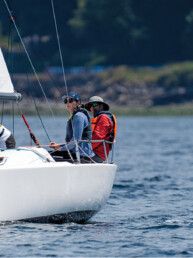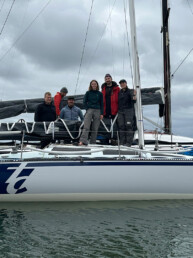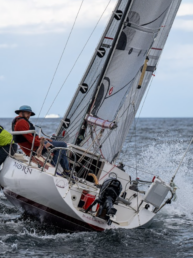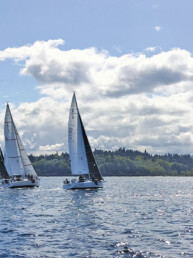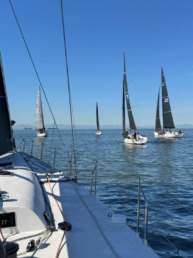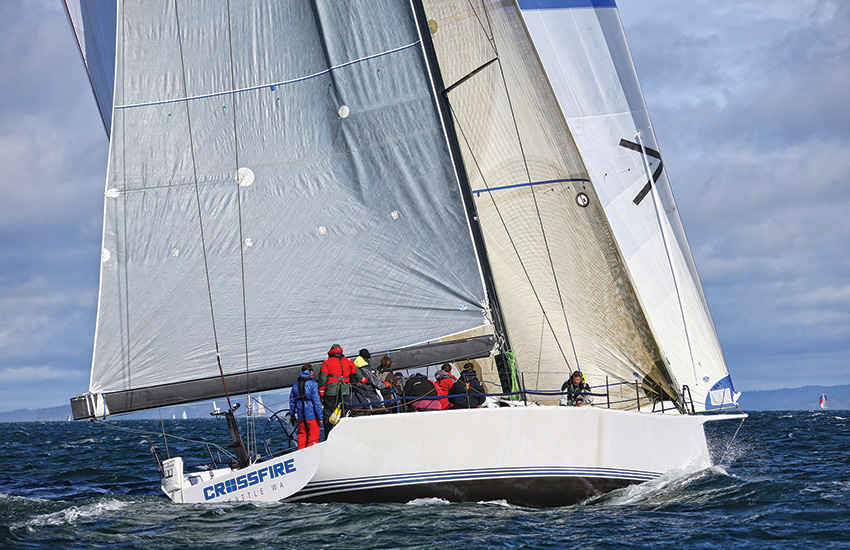
This article, by Cara Kuhlman, originally appeared in the December 2016 issue of 48° North.
In the early miles of the 2016 Victoria to Maui International Yacht Race, Crossfire, a 55-foot custom Reichel-Pugh race boat, flew like a rocket, reaching a record speed of 32.5 knots. Crossfire’s experienced 10-person crew – including owner Lou Bianco, navigator Bruce Hedrick, and boat manager Nigel Barron – was on track to cover more than 400 miles in 24 hours. However, despite this early progress, when the Vic-Maui time record fell, Crossfire would be safely home in Seattle.
Crossfire’s retirement from Vic-Maui has been a hot-button topic for sailors around the Northwest and beyond. Hedrick’s immediate report about why they called it quits has been shared in various outlets. The situation has been widely discussed and, on occasion, criticized. But, the largely untold story involving the decision to turn back and subsequent events reveals the challenges they faced and highlights the good seamanship and prudence that both motivated the choice to retire and brought them safely home when further gear failure threatened boat and crew.
Celebrating its half-century, the 2016 Vic-Maui race began in mid-July with 22 boats competing in a race spanning the 2,308 nautical miles from Victoria, BC to Lahaina, Maui. From the start, spectators closely tracked racers while racers closely tracked forecasts, including the trajectory of several tropical storms developing near Hawaii. What the GRIB files don’t reveal and what race trackers can’t show, however, are the unexpected breakdowns and resulting seamanship that defines such a race and its competitors.
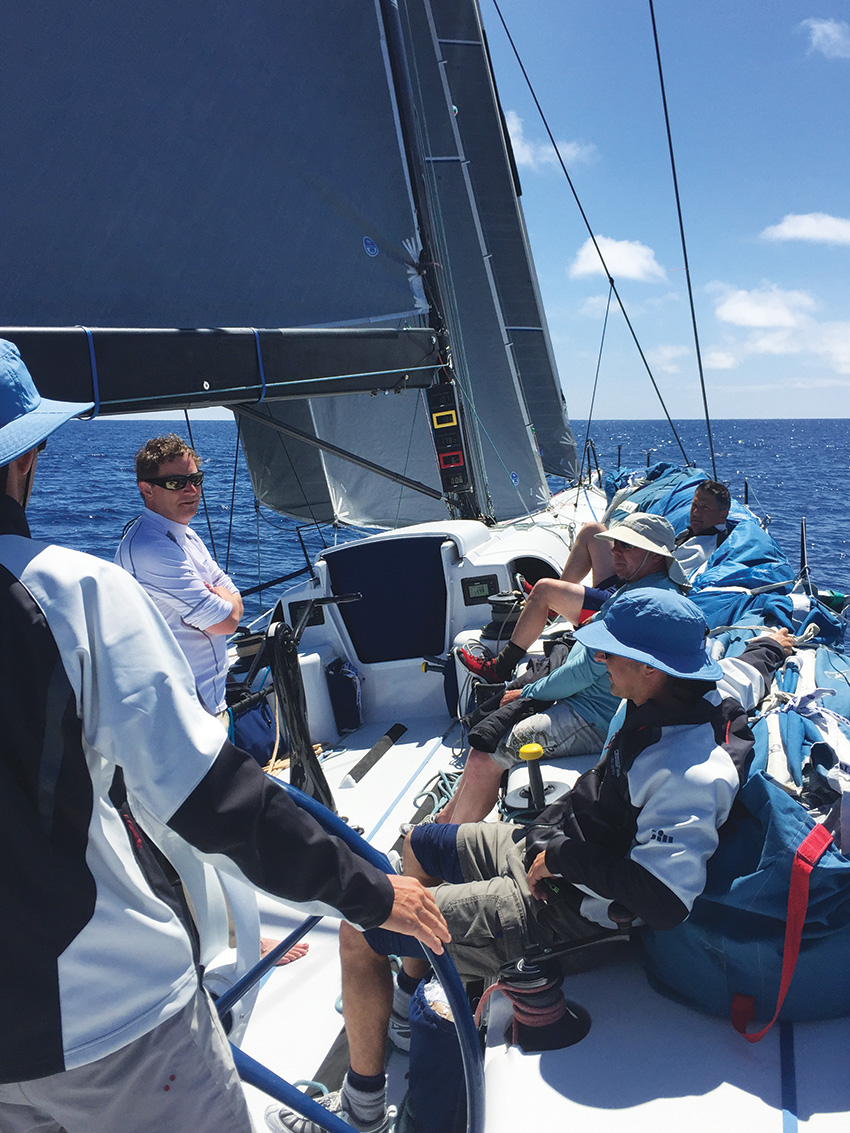
Approximately 450 miles offshore, the Crossfire crew found itself racing along in a confused sea state with 25-30 knots of wind, not stressed but instead focused on staying ahead of the seemingly endless sequence of tropical storms. After losing the A4 spinnaker when the clew blew out, Crossfire sailed on with the A5 until things changed abruptly when the fractional halyard failed.
Quick to respond, the crew secured the wet and shredded sail. They continued under staysail and main and took stock of the situation, still making 15 knots of boat speed. For navigator Bruce Hedrick, the severity of the situation began to stack up with the uncertainty about the integrity of the other halyards, which came with the boat when it was purchased and brought to Seattle less than an year earlier. Additionally, they had lost both of their heavy air racing spinnakers. Finally, when he considered the incoming tropical storms and reduced sail inventory, he wondered, “are we still going to get in front of them?”
Nigel Barron, a longtime crewmate of Hedrick’s and a key part of the Crossfire program, reached a similar conclusion, especially acknowledging Hedrick’s experience and acumen as a navigator and weather router.
Barron, Hedrick, owner Lou Bianco, and another experienced crewmember, John Stanley, privately discussed the situation and weighed the risks of continuing or retiring. Experience told them it was time to turn home, their competitive edge lost and the boat getting further from the mainland by the minute.
“It was hard because someone has to make that decision,” says Barron. Preparation, innumerable hours of boat work, vacation time, and financial investment in the boat and the race, all made the choice difficult, but Barron continued, “we knew that if we fail, we must fail to safety.” The four made the final call to retire unanimously, understanding that some of the crew would be disappointed.
This was the first of several crucial decisions that tested the Crossfire crew’s skill, stomachs, and seamanship. Crossfire retired from the Vic-Maui race, hoping to save the boat and crew from additional wear and tear and make the safest choice. They decided to sail back to Seattle, instead of locations in California or Oregon, which were closer, because of the increasingly windy weather along their coastlines, and the fact that they had the crew, the supplies, and the time to avoid a difficult delivery in the future.
They sailed north towards the Pacific high, which might have looked like a heading that didn’t really bring them closer to home, but Hedrick knew it was in the best interest to sail in the direction of more moderate breeze. The crew lowered and secured the main, a long and arduous process with that big a sail in that much breeze. They sailed on under jib alone at 7-8 knots. The unexpected beat upwind was uncomfortable and seasickness set in amongst some crewmembers.
After 24 hours of bouncing and pounding, Crossfire tacked toward home in the afternoon as planned. Closer to the high, the wind had backed off to 15 or 20 knots, but the sea state remained significant and confused.
Three hours after the tack, it was still daylight when there was a loud “BOOM!” Clearly, it was the sound of something breaking, but what had happened? Hedrick was at the helm and turned the boat off the wind, reducing the load on the rig to buy some time to determine what had happened.
Right away, they could see a lot of slack in the luff of the headsail and the crew on deck didn’t hesitate, moving quickly to set halyards forward. Barron said his feet barely touched the deck as he sprinted from the back of the boat. Two spinnaker halyards were run to the tack fitting on the bow, and the genoa staysail halyard attached to the staysail fitting in the middle of the foredeck to stabilize the rig.
“This isn’t the first time I’ve been on a boat that lost a headstay” Barron added, “That slack and the ballooning of the luff curve was a clear indicator of what happened.” The stem ball fitting at the top of the mast had broken, releasing the headstay and imperiling the rig.
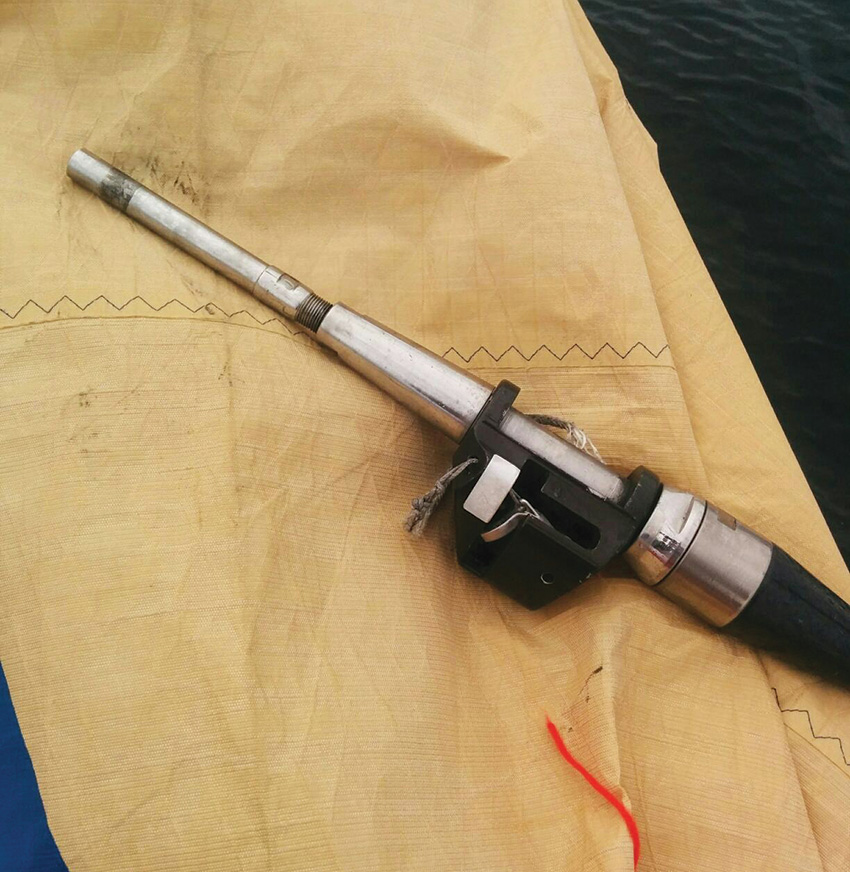
Despite the intensity of the moment, the crew remained cautious and thorough. For example, following the breakdown, they started the engine but waited to shift into gear. They did a full line check and inspected around the keel, rudder and propeller using an endoscope.
They suspected there might be some debris under the boat based on the way it was sailing. They held off shifting into gear until a large section of synthetic line floated up from under the boat, most likely part of a freighter dock line.
With the rig relatively secure, the keel clear and the engine in gear, Crossfire faced a new challenge: getting to land with just under 20 gallons of fuel, hundreds of miles still to go, with a damaged rig.
In Hedrick’s view, they were still safe and in control; the boat didn’t have a hole, they had plenty of food and water, and above all, no one was injured. They alerted the Coast Guard, Vic-Maui organizers, and supporters on shore to the situation, but remained confident they could bring the boat home.
Looking back, Barron says, “We stayed one step in front of bad the whole way.”
An offshore veteran, Hedrick knows how quickly disasters can add up. “A sequence of seemingly small events can lead to big problems,” he says, “it came down to decision calculus.”
For Hedrick, the newest equation involved fuel economy and the most direct course to land, in this case, Neah Bay. He and Barron calculated, re-calculated and closely monitored the fuel level, remaining conservative in their estimates.
They motored all night at about 5.5 knots, maintaining a low RPM to conserve fuel. However, to make it to Neah Bay, they would still have to sail for over 100 miles. Given the damaged rig and some uncertainty about the integrity of the halyards, hoisting any kind of sail was a risky proposition.
Their first step was to hoist the genoa staysail, which has a spectra luff that is nearly as strong as the halyard that was currently being used to help keep the rig stable. It worked, the rig was solid, and they were able to make a few knots of boat speed toward Neah Bay on a close-reach course. They turned the engine off. Later, they added the storm tri-sail. The sea state calmed down and the breeze dropped to 10-12 knots while Crossfire progressed at 5-7 knots.
Fuel economy remained their focus: What do we have for fuel? What do we have for range? How close do we have to get?
At dawn, the seas were calm and they felt confident about making it into Neah Bay with the remaining amount of fuel. Eighty miles outside of Neah Bay, they decided to drop sail and Crossfire slowly motored the rest of the way.
At 8 a.m. they arrived in Neah Bay with approximately three gallons of fuel left. They had been out for seven days. After losing the headstay, the choice to retire had unanimous support and the mission became to get the boat and the crew back safe and sound. Mission accomplished.
Without sailing, Hedrick and Barron estimate they would have run out of fuel 30-40 miles outside of Neah Bay. By sailing, they were able to conserve fuel until the final stretch and refuel in Neah Bay, never needing outside assistance.
Their fuel tank full, Crossfire set out again, stopping in Port Angeles to clear customs before reaching Shilshole Bay Marina at 3 a.m. where they were greeted by their families with pizzas and Mai Tais. Relieved and tired, it wasn’t lost on the crew that the Mai Tais were on a different side of the Pacific than planned. Thirsty for more, several of the Crossfire crew flew to Maui after their return and participated in the Vic-Maui festivities at the Lahaina Yacht Club.
In the months that have followed, the Crossfire team is applying their experience both above and below deck to repair and improve the boat for future offshore endeavors. The future Crossfire calendar includes the Trans Pac and Pacific Cup races, both of which are celebrating 50 years similar to the Vic-Maui.
With the confidence that they have a very fast boat and a great crew that knows when to charge forward and when reign it in, the crew of Crossfire see a bright future for the racing program. However, no matter the plan, the decision calculus has to add up and when challenges arise, they will always “fail to safety.”
Cara Kuhlman is a Seattle-based writer, sailor, and craft beer enthusiast.
Joe Cline
Joe Cline has been the Managing Editor of 48° North since 2014. From his career to his volunteer leadership in the marine industry, from racing sailboats large and small to his discovery of Pacific Northwest cruising —Joe is as sail-smitten as they come. Joe and his wife, Kaylin, have welcomed a couple of beautiful kiddos in the last few years, and he is enjoying fatherhood while still finding time to make a little music and even occasionally go sailing.

